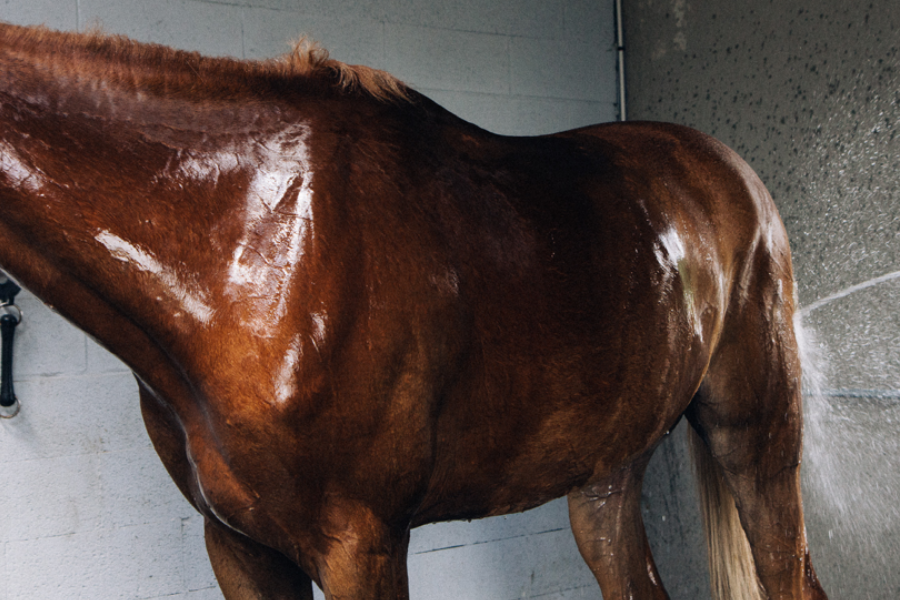As the temperatures rise, it’s essential to take extra care when riding and managing your horse. Summer heat can pose significant challenges for both horse and rider. Ensuring your horse stays cool is crucial for their health and performance. Here’s what you need to know about the impact of heat on horses, how to keep them cool, and recognizing signs of heat stroke.
Understanding the Physiological Impact of Heat on Horses
Horses, like humans, can struggle with high temperatures. Here’s how heat affects them physiologically:
- Thermoregulation: Horses have a natural ability to regulate their body temperature. They do this primarily through sweating. However, excessive heat can overwhelm this mechanism, leading to overheating.
- Electrolyte Imbalance: Sweating leads to the loss of essential electrolytes such as sodium, potassium, and chloride. These are crucial for muscle function and overall cellular processes.
- Dehydration: Prolonged sweating without adequate fluid intake can lead to dehydration, affecting blood volume and circulation.
- Increased Heart Rate and Respiratory Rate: To cool down, horses increase their heart and respiratory rates. Over time, this can cause significant stress on their cardiovascular and respiratory systems.
Tips for Keeping Your Horse Cool
- Hydration is Key: Always provide access to fresh, cool water. Consider offering electrolyte supplements to replace those lost through sweating.
- Shade and Shelter: Ensure your horse has access to shade, whether it’s a tree, a shelter, or a well-ventilated barn.
- Timing of Rides: Ride during the cooler parts of the day, such as early morning or late evening. Avoid riding during peak heat hours.
- Cool Down Procedures: After a ride, cool your horse down gradually. Hose them with cool (not cold) water, focusing on large blood vessels on the neck, chest, and legs.
- Clipping: For horses with thick coats, clipping can help them stay cooler by allowing sweat to evaporate more efficiently.
Recognizing Heat Stroke in Horses
Heat stroke is a severe and potentially life-threatening condition. Here are signs to watch for:
- Excessive Sweating or Lack of Sweat: Horses might sweat profusely or, conversely, stop sweating despite being hot (anhidrosis).
- Rapid Breathing and Elevated Heart Rate: While increased rates are normal during exercise, they should return to normal within a reasonable period. Prolonged elevation is a warning sign.
- Lethargy and Weakness: A horse that’s unusually sluggish or seems weak may be overheating.
- Elevated Body Temperature: Normal body temperature for horses is between 99.5°F and 101.5°F (37.5°C – 38.6°C). Temperatures above this range indicate heat stress.
- Stumbling or Poor Coordination: Neurological signs can emerge as heat stroke progresses.
- Dark or Reduced Urine Output: Signs of severe dehydration include dark-colored urine or a noticeable decrease in urination frequency.
Immediate Actions if You Suspect Heat Stroke
If you notice any signs of heat stroke, act immediately:
- Move to Shade: Get your horse out of the sun and into a cool, shaded area.
- Cool Down: Use cool water to sponge or hose down your horse, focusing on large blood vessels and areas with less hair. Avoid ice-cold water, as it can cause blood vessels to constrict and impede cooling.
- Encourage Drinking: Offer water frequently in small amounts.
- Call a Veterinarian: Heat stroke is an emergency. Professional medical intervention may be necessary to stabilize your horse.
Final Thoughts
Riding in the heat requires careful planning and a keen eye on your horse’s condition. By understanding the physiological impacts of heat, implementing cooling strategies, and recognizing the signs of heat stroke, you can ensure your horse stays healthy and comfortable throughout the summer. Don’t hesitate to contact us for more tips on equine care or to schedule an appointment. Stay cool and happy riding.
